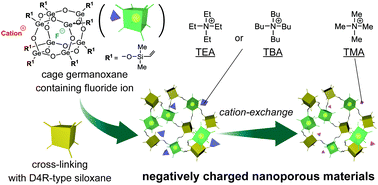Variation of counter quaternary ammonium cations of anionic cage germanoxanes as building blocks of nanoporous materials†
Abstract
Double-four ring (D4R)-type cage germanoxanes, having a fluoride anion in the cage, contain organic ammonium cations as counter cations outside the cage, and they are attractive as unique nano-building blocks of anionic porous materials. Although the variety of counter cations directly included in the cage germanoxane synthesis is limited, this study demonstrates that other tetraalkylammonium cations can be introduced by cation exchange in both discrete and cross-linked states. Tetraethylammonium (TEA) of a discrete cage germanoxane was replaced with tetrabutylammonium (TBA) in an organic solvent, which provides another starting material. TEA and TBA cations in cross-linked networks formed by hydrosilylation reactions of dimethylvinylsilylated cage germanoxanes with various oligosiloxanes as linkers were exchanged with tetramethylammonium (TMA) cations. The variation in the pore volume, which depends on the type of introduced counter cations and oligosiloxane linkers, is verified. In terms of bottom-up synthesis of nanoporous materials from cage-type germanoxanes, the selection of both the counter cation and cross-linker is important to vary the porosity.



 Please wait while we load your content...
Please wait while we load your content...